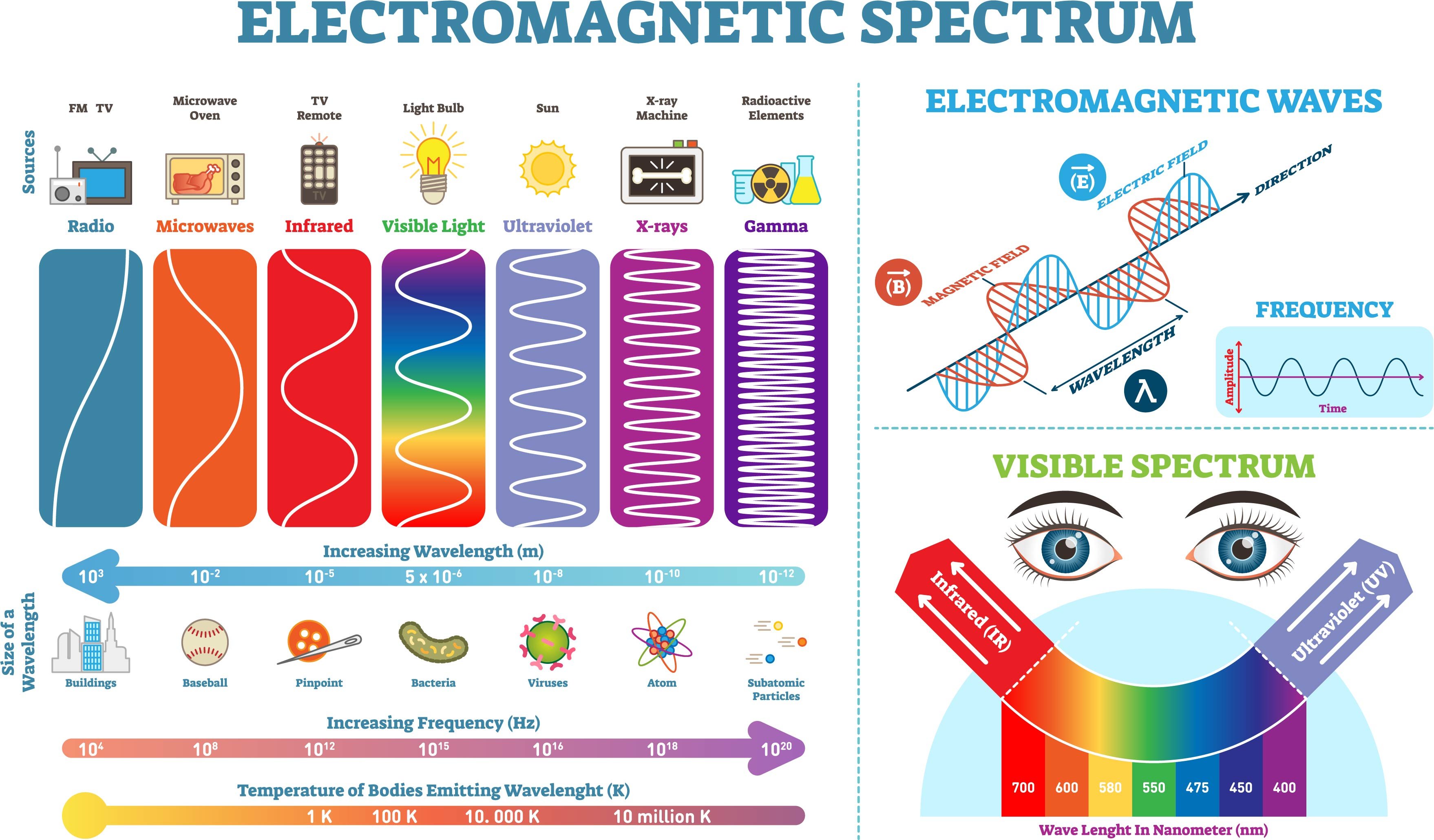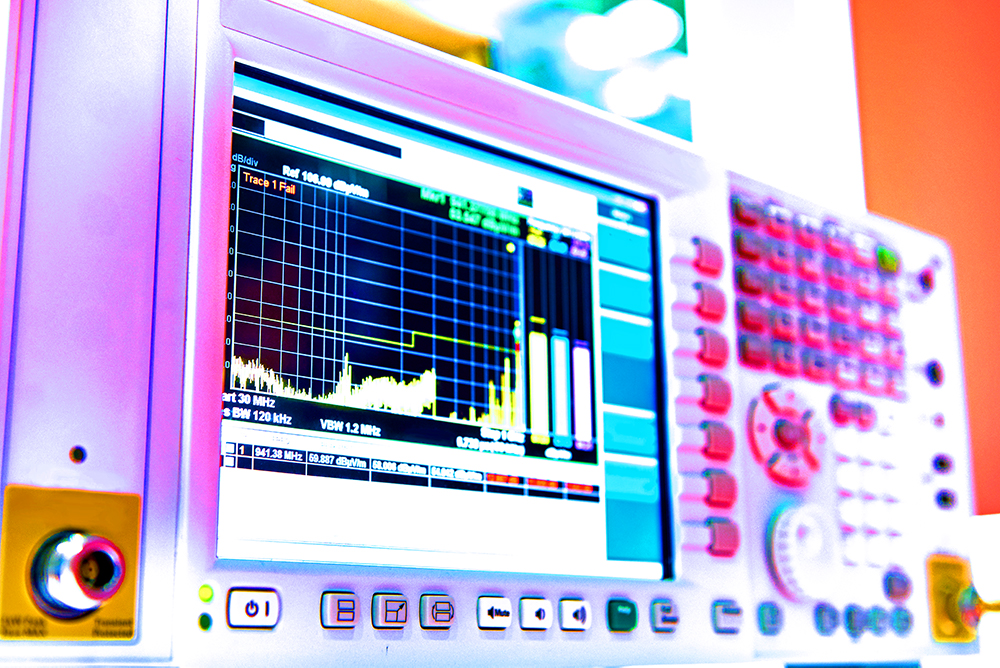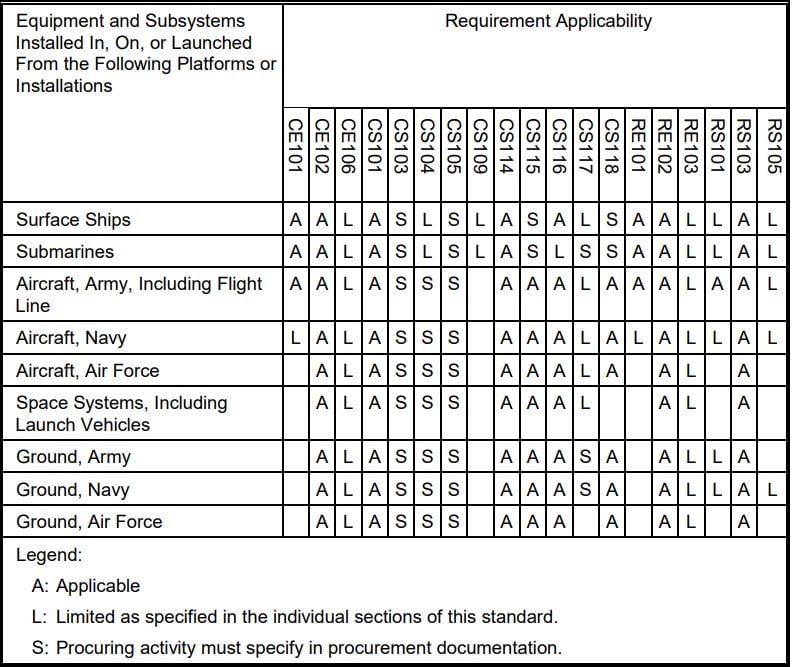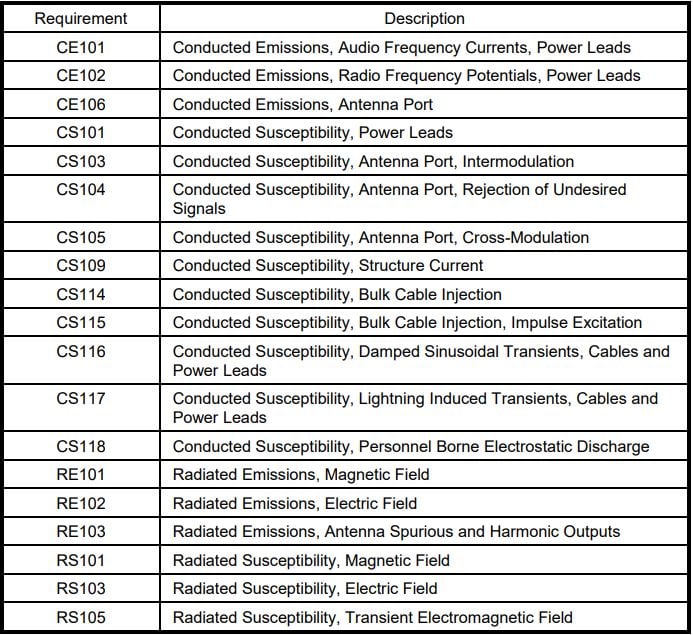Share this
MIL-STD-461: Everything You Need to Know
by Brett Daniel on Jun 26, 2020 8:28:25 AM
-1.png?width=1000&name=Untitled%20design%20(31)-1.png)
Graphic: If your rugged server or workstation is expected to operate in proximity to any number of electrical and electronic systems, a MIL-STD-461 compliance certification is an absolute must.
Note: Trenton Systems is not a compliance testing facility. We manufacture rugged servers and workstations that conform to military and industrial standards, such as MIL-STD-810 and DO-160, and we can ensure that our systems comply with these standards using our in-house testing equipment, or by sending our systems to a third-party compliance testing laboratory for validation, but our facility does not offer compliance testing services for products manufactured outside of Trenton Systems. For a list of laboratories that can assist you with your testing needs, please read this blog post, which lists the best compliance testing laboratories in the world.
For more information on military and industrial standards, check out our MIL-STD-810 series, which begins with MIL-STD-810 temperature testing, as well as our DO-160 blog post.
At Trenton Systems, we use the United States Department of Defense's MIL-STD-461 to test and certify our made-in-USA rugged servers, workstations, PCIe backplanes and processor boards for electromagnetic compatibility.
MIL-STD-461 is an important testing standard for our military customers. It ensures that the ruggedized computer systems they purchase from us can function properly within electromagnetic (EM) environments and avoid releasing EM energy that could potentially cause electromagnetic interference (EMI) with nearby devices.
Whew. That’s an electromagnetic mouthful.
Nonetheless, in this blog post, we’ll discuss the MIL-STD-461 document, EM interference as it relates to MIL-STD-461 and the importance of electromagnetic compatibility in general.
We don’t know about you, but for some reason, we're feeling pretty - charged - about this blog post.

Graphic: An overview of the electromagnetic spectrum with examples of devices and their wavelength types
MIL-STD-461 testing: What is it?
MIL-STD-461, currently MIL-STD-461G, is an electromagnetic compatibility testing standard published and maintained by the United States Department of Defense (U.S. DoD). Its official title is Requirements for the Control of Electromagnetic Interference Characteristics of Subsystems and Equipment.
The MIL-STD-461 document is applied to electrical or electronic systems, e.g., rugged servers and workstations, used in military programs and applications. A MIL-STD-461 certification ensures that a system doesn’t suffer from EM interference or disrupt other devices near it.
“This standard is best suited for items that have the following features: electronic enclosures that are no larger than an equipment rack, electrical interconnections that are discrete wiring harnesses between enclosures, and electrical power input derived from prime power sources.”
- Excerpt from MIL-STD-461
MIL-STD-461 is a tried-and-true electromagnetic testing standard dating back as far as 1967, when the DoD first issued the document to establish EM compatibility requirements for defense technology as parts of its Electromagnetic Compatibility Program.
Since its initial publication in 1967, MIL-STD-461 has undergone a total of seven revisions:
- MIL-STD-461A (1968)
- MIL-STD-461B (1980)
- MIL-STD-461C (1986)
- MIL-STD-461D (1993)
- MIL-STD-461E (1999)
- MIL-STD-461F (2007)
- MIL-STD-461G (2015)
MIL-STD-461 is a common requirement for military programs and systems, which is why Trenton Systems works closely with compliance laboratories and defense contractors to ensure that our rugged servers are up to par.
Depending on the type of MIL-STD-461 testing that is required, the majority of Trenton Systems' MIL-STD-461 testing is performed at some of our off-site test laboratories.
The United States military is concerned with how electromagnetic compatibility affects components and sub-components in their vehicles, aircraft and ships.
- Gary Ziadeh, compliance coordinator at Trenton Systems

Photo: An electromagnetic field measurement receiver, used in MIL-STD-461 testing
Why is MIL-STD-461 important?
MIL-STD-461 testing is important for safety and mission success. Space-constrained programs and applications that utilize numerous embedded computer systems are growing in number, and thus, the propensity for EMI between them is growing, too.
Given that our mission-critical servers power high-stakes systems and applications for the military, the assurance to military personnel that their systems won’t be disrupted by EMI is crucial.
Electrical and electronic systems operating in proximity to each other have the propensity to emit or be susceptible to EMI, which can cause a decline in performance or shut the systems down completely.
If a rugged server or workstation isn’t MIL-STD-461-compliant but is being used as part of a mission-critical system, there’s an increased likelihood of mission disruption, mission failure and even a total loss of data, all of which carry potentially disastrous consequences, especially when national security is at play.
Even worse, enemy forces may also hijack the electromagnetic spectrum and disrupt electrical and electronic systems being used by the U.S. military. This weaponization of the EM spectrum is known as electronic warfare.
MIL-STD-461 testing offers an added layer of EMI protection for military systems and reassurance to military personnel that their systems likely won’t be disrupted by EMI.
MIL-STD-461 Requirement Matrix

Table: The MIL-STD-461 Requirement Matrix. This table outlines the different MIL-STD-461 test procedures and their applicability to equipment and subsystems installed on major military platforms and installations.
What tests are in MIL-STD-461?
MIL-STD-461 test procedures are designated by an alphanumeric coding system.
Each MIL-STD-461 requirement is identified by three-digit number succeeding a two-letter combination.
- Conducted emissions requirements are designated by CE
- Radiated emissions requirements are designated by RE
- Conducted susceptibility requirements are designated by CS
- Radiated susceptibility requirements are designated by RS
Conducted emissions refer to EM energy generated by a system or device and transmitted through its power cord via an electric current.
Radiated emissions, on the other hand, refer to the unintentional generation of EM energy from a system or device.
In turn, conducted susceptibility and radiated susceptibility refer to a device’s or system’s vulnerability to conducted and radiated emissions, respectively. These can also be referred to as conducted immunity and radiated immunity, which instead specify a system’s or device’s resistance to both types of emissions.
Some of the more commonly discussed tests in MIL-STD-461 are:
- MIL-STD-461G CE102
- MIL-STD-461G CS116
- MIL-STD-461G RS103
What is MIL-STD-461G CE102?
MIL-STD-461G CE102 ensures that EM emissions from the equipment being tested do not exceed the power lead and AC / DC limits outlined in Figure CE102-1 of MIL-STD-461.
MIL-STD-461G CE102 is applicable to equipment installed on:
- Surface ships
- Submarines
- Army, Navy and Air Force aircraft
- Space systems, including launch vehicles
- Army, Navy and Air Force ground platforms and installations
What is MIL-STD-461G CS116?
MIL-STD-461G CS116 tests the ability of equipment to endure damped sinusoidal transients coupled onto equipment cables and power leads.
MIL-STD-461G CS116 is applicable to equipment installed on surface ships, military aircraft, space systems and launch vehicles and military ground platforms and installations. It is limited in applicability to submarines.
What is MIL-STD-461G RS103?
MIL-STD-461G RS103 assesses the ability of equipment and its cabling to withstand electric fields.
MIL-STD-461G RS103 is applicable to equipment installed on surface ships, submarines, military aircraft, space systems and launch systems and military ground platforms and installations.
MIL-STD-461 Emission & Susceptibility Requirements

Table: MIL-STD-461's Emission and Susceptibility Requirements. This table lists the standard's test procedures in the left-hand column and brief descriptions of each procedure in the right-hand column.
The 19 Different MIL-STD-461 Tests
In total, there are 19 electromagnetic compatibility test procedures in MIL-STD-461. We’ve listed the procedures and their purposes below:
Conducted Emissions Tests (CE)
- CE101: Audio Frequency Currents & Power Leads - used to verify that electromagnetic emissions from the equipment under test (EUT) do not exceed the specified requirements for power input leads, including returns
- CE102: Radio Frequency Potentials & Power Leads - used to verify that electromagnetic emissions from the EUT do not exceed the specified requirements for power input leads, including returns
- CE106: Antenna Port - used to verify that conducted emissions appearing at the antenna port of the EUT do not exceed specified requirements
Conducted Susceptibility (CS) Tests
- CS101: Power Leads - used to verify the ability of the EUT to withstand signals coupled onto input power leads
- CS103: Antenna Port & Intermodulation - used to determine the presence of intermodulation products that may be caused by undesired signals at the EUT antenna input ports
- CS104: Antenna Port & Rejection of Undesired Signals - used to determine the presence of spurious responses that may be caused by undesired signals at the EUT antenna input ports
- CS105: Antenna Port & Cross-Modulation - used to determine the presence of cross-modulation products that may be caused by undesired signals at the EUT antenna ports
- CS109: Transients & Power Leads - used to verify the ability of the EUT to withstand structure currents
- CS114: Bulk Cable Injection - used to verify the ability of the EUT to withstand radio frequency (RF) signals coupled onto EUT associated cabling
- CS115: Bulk Cable Injection & Impulse Excitation - used to verify the ability of the EUT to withstand impulse signals coupled onto EUT associated cabling
- CS116: Damped Sinusoidal Transients, Cables & Power Leads - used to verify the ability of the EUT to withstand damped sinusoidal transients coupled onto EUT-associated cables and power leads
- CS117: Lightning-Induced Transients, Cables & Power Leads - used to verify the ability of the EUT to withstand lightning transients coupled onto EUT associated cables and power leads
- CS118: Personnel-Borne Electrostatic Discharge - used to verify the ability of the EUT to withstand personnel borne electrostatic discharge (ESD) in a powered-up configuration
Radiated Emissions (RE) Tests
- RE101: Magnetic Field - used to verify that the magnetic field emissions from the EUT and its associated electrical interfaces do not exceed specified requirements
- RE102: Electric Field - used to verify that electric field emissions from the EUT and its associated cabling do not exceed specified requirements
- RE103: Antenna Spurious & Harmonic Outputs - used to verify that radiated spurious and harmonic emissions from transmitters do not exceed the specified requirements
Radiated Susceptibility (RS) Tests
- RS101: Magnetic Field - used to verify the ability of the EUT to withstand radiated magnetic fields
- RS103: Electric Field - used to verify the ability of the EUT and associated cabling to withstand electric fields
- RS105: Transient Electromagnetic Field - used to verify the ability of the EUT enclosure to withstand a transient electromagnetic field
MIL-STD-461 vs. MIL-STD-464
MIL-STD-461 and MIL-STD-464 are sometimes confused because they both address electromagnetism and electromagnetic environments.
The difference between MIL-STD-461 and MIL-STD-464, however, is quite simple. The former addresses specific pieces of equipment and subsystems, and the latter addresses systems and platforms at large.
“This standard establishes electromagnetic environmental effects (E3) interface requirements and verification criteria for airborne, sea, space, and ground systems, including associated ordnance.”
- Excerpt from MIL-STD-464
In short, MIL-STD-464 is a collection of baseline system- and platform-level requirements and verification methods for fully assembled systems – the submarine, the launch vehicle, the surface ship and the others mentioned in MIL-STD-461.
It’s helpful to think of MIL-STD-464 as the integrated system standard for electromagnetic compatibility. MIL-STD-461, on the other hand, dives into the specifics of EMC testing for the smaller equipment and subsystems. It also serves as a testing guide for compliance testing engineers.
Furthermore, MIL-STD-464 addresses system life cycle stages as they relate to E3. These stages include normal operation, packaging, transportation, storage, among others.
Conclusion
There's hardly a debate to be had.
If your rugged server, workstation or mini PC is expected to operate in proximity to any number of electrical and electronic systems, a MIL-STD-461 compliance certification is a must.
Some Trenton Systems products that have undergone MIL-STD-461G testing include but are not limited to our:
Trenton Systems not only recognizes the money, time and energy that EMI damage can zap, but the path of destruction it can leave in its wake.
That's why we take great care when certifying our systems to MIL-STD-461.
Electromagnetic compatibility is essential, but our military customers have much more important matters to tend to.
Share this
- High-performance computers (42)
- Military computers (38)
- Rugged computers (32)
- Cybersecurity (25)
- Industrial computers (25)
- Military servers (24)
- MIL-SPEC (20)
- Rugged servers (19)
- Press Release (17)
- Industrial servers (16)
- MIL-STD-810 (16)
- 5G Technology (14)
- Intel (13)
- Rack mount servers (12)
- processing (12)
- Computer hardware (11)
- Edge computing (11)
- Rugged workstations (11)
- Made in USA (10)
- Partnerships (9)
- Rugged computing (9)
- Sales, Marketing, and Business Development (9)
- Trenton Systems (9)
- networking (9)
- Peripheral Component Interconnect Express (PCIe) (7)
- Encryption (6)
- Federal Information Processing Standards (FIPS) (6)
- GPUs (6)
- IPU (6)
- Joint All-Domain Command and Control (JADC2) (6)
- Server motherboards (6)
- artificial intelligence (6)
- Computer stress tests (5)
- Cross domain solutions (5)
- Mission-critical servers (5)
- Rugged mini PCs (5)
- AI (4)
- BIOS (4)
- CPU (4)
- Defense (4)
- Military primes (4)
- Mission-critical systems (4)
- Platform Firmware Resilience (PFR) (4)
- Rugged blade servers (4)
- containerization (4)
- data protection (4)
- virtualization (4)
- Counterfeit electronic parts (3)
- DO-160 (3)
- Edge servers (3)
- Firmware (3)
- HPC (3)
- Just a Bunch of Disks (JBOD) (3)
- Leadership (3)
- Navy (3)
- O-RAN (3)
- RAID (3)
- RAM (3)
- Revision control (3)
- Ruggedization (3)
- SATCOM (3)
- Storage servers (3)
- Supply chain (3)
- Tactical Advanced Computer (TAC) (3)
- Wide-temp computers (3)
- computers made in the USA (3)
- data transfer (3)
- deep learning (3)
- embedded computers (3)
- embedded systems (3)
- firmware security (3)
- machine learning (3)
- Automatic test equipment (ATE) (2)
- C6ISR (2)
- COTS (2)
- COVID-19 (2)
- CPUs (2)
- Compliance (2)
- Compute Express Link (CXL) (2)
- Computer networking (2)
- Controlled Unclassified Information (CUI) (2)
- DDR (2)
- DDR4 (2)
- DPU (2)
- Dual CPU motherboards (2)
- EW (2)
- I/O (2)
- Military standards (2)
- NVIDIA (2)
- NVMe SSDs (2)
- PCIe (2)
- PCIe 4.0 (2)
- PCIe 5.0 (2)
- RAN (2)
- SIGINT (2)
- SWaP-C (2)
- Software Guard Extensions (SGX) (2)
- Submarines (2)
- Supply chain security (2)
- TAA compliance (2)
- airborne (2)
- as9100d (2)
- chassis (2)
- data diode (2)
- end-to-end solution (2)
- hardware security (2)
- hardware virtualization (2)
- integrated combat system (2)
- manufacturing reps (2)
- memory (2)
- mission computers (2)
- private 5G (2)
- protection (2)
- secure by design (2)
- small form factor (2)
- software security (2)
- vRAN (2)
- zero trust (2)
- zero trust architecture (2)
- 3U BAM Server (1)
- 4G (1)
- 4U (1)
- 5G Frequencies (1)
- 5G Frequency Bands (1)
- AI/ML/DL (1)
- Access CDS (1)
- Aegis Combat System (1)
- Armed Forces (1)
- Asymmetric encryption (1)
- C-RAN (1)
- COMINT (1)
- Cloud-based CDS (1)
- Coast Guard (1)
- Compliance testing (1)
- Computer life cycle (1)
- Containers (1)
- D-RAN (1)
- DART (1)
- DDR5 (1)
- DMEA (1)
- Data Center Modular Hardware System (DC-MHS) (1)
- Data Plane Development Kit (DPDK) (1)
- Defense Advanced Research Projects (DARP) (1)
- ELINT (1)
- EMI (1)
- EO/IR (1)
- Electromagnetic Interference (1)
- Electronic Warfare (EW) (1)
- FIPS 140-2 (1)
- FIPS 140-3 (1)
- Field Programmable Gate Array (FPGA) (1)
- Ground Control Stations (GCS) (1)
- Hardware-based CDS (1)
- Hybrid CDS (1)
- IES.5G (1)
- ION Mini PC (1)
- IP Ratings (1)
- IPMI (1)
- Industrial Internet of Things (IIoT) (1)
- Industry news (1)
- Integrated Base Defense (IBD) (1)
- LAN ports (1)
- LTE (1)
- Life cycle management (1)
- Lockheed Martin (1)
- MIL-S-901 (1)
- MIL-STD-167-1 (1)
- MIL-STD-461 (1)
- MIL-STD-464 (1)
- MOSA (1)
- Multi-Access Edge Computing (1)
- NASA (1)
- NIC (1)
- NIC Card (1)
- NVMe (1)
- O-RAN compliant (1)
- Oil and Gas (1)
- Open Compute Project (OCP) (1)
- OpenRAN (1)
- P4 (1)
- PCIe card (1)
- PCIe lane (1)
- PCIe slot (1)
- Precision timestamping (1)
- Product life cycle (1)
- ROM (1)
- Raytheon (1)
- Remotely piloted aircraft (RPA) (1)
- Rugged computing glossary (1)
- SEDs (1)
- SIM Card (1)
- Secure boot (1)
- Sensor Open Systems Architecture (SOSA) (1)
- Small form-factor pluggable (SFP) (1)
- Smart Edge (1)
- Smart NIC (1)
- SmartNIC (1)
- Software-based CDS (1)
- Symmetric encryption (1)
- System hardening (1)
- System hardening best practices (1)
- TME (1)
- Tech Partners (1)
- Total Memory Encryption (TME) (1)
- Transfer CDS (1)
- USB ports (1)
- VMEbus International Trade Association (VITA) (1)
- Vertical Lift Consortium (VLC) (1)
- Virtual machines (1)
- What are embedded systems? (1)
- Wired access backhaul (1)
- Wireless access backhaul (1)
- accredidation (1)
- aerospace (1)
- air gaps (1)
- airborne computers (1)
- asteroid (1)
- authentication (1)
- autonomous (1)
- certification (1)
- cognitive software-defined radios (CDRS) (1)
- command and control (C2) (1)
- communications (1)
- cores (1)
- custom (1)
- customer service (1)
- customer support (1)
- data linking (1)
- data recording (1)
- ethernet (1)
- full disk encryption (1)
- hardware monitoring (1)
- heat sink (1)
- hypervisor (1)
- in-house technical support (1)
- input (1)
- integrated edge solution (1)
- international business (1)
- licensed spectrum (1)
- liquid cooling (1)
- mCOTS (1)
- microelectronics (1)
- missile defense (1)
- mixed criticality (1)
- moving (1)
- multi-factor authentication (1)
- network slicing (1)
- neural networks (1)
- new headquarters (1)
- next generation interceptor (1)
- non-volatile memory (1)
- operating system (1)
- output (1)
- outsourced technical support (1)
- post-boot (1)
- pre-boot (1)
- private networks (1)
- public networks (1)
- radio access network (RAN) (1)
- reconnaissance (1)
- rugged memory (1)
- secure flash (1)
- security (1)
- self-encrypting drives (SEDs) (1)
- sff (1)
- software (1)
- software-defined radios (SDRs) (1)
- speeds and feeds (1)
- standalone (1)
- storage (1)
- systems (1)
- tactical wide area networks (1)
- technical support (1)
- technology (1)
- third-party motherboards (1)
- troposcatter communication (1)
- unlicensed spectrum (1)
- volatile memory (1)
- vpx (1)
- zero trust network (1)
- January 2025 (1)
- November 2024 (1)
- October 2024 (1)
- August 2024 (1)
- July 2024 (1)
- May 2024 (1)
- April 2024 (3)
- February 2024 (1)
- November 2023 (1)
- October 2023 (1)
- July 2023 (1)
- June 2023 (3)
- May 2023 (7)
- April 2023 (5)
- March 2023 (7)
- December 2022 (2)
- November 2022 (6)
- October 2022 (7)
- September 2022 (8)
- August 2022 (3)
- July 2022 (4)
- June 2022 (13)
- May 2022 (10)
- April 2022 (4)
- March 2022 (11)
- February 2022 (4)
- January 2022 (4)
- December 2021 (1)
- November 2021 (4)
- September 2021 (2)
- August 2021 (1)
- July 2021 (2)
- June 2021 (3)
- May 2021 (4)
- April 2021 (3)
- March 2021 (3)
- February 2021 (8)
- January 2021 (4)
- December 2020 (5)
- November 2020 (5)
- October 2020 (4)
- September 2020 (4)
- August 2020 (6)
- July 2020 (9)
- June 2020 (11)
- May 2020 (13)
- April 2020 (8)
- February 2020 (1)
- January 2020 (1)
- October 2019 (1)
- August 2019 (2)
- July 2019 (2)
- March 2019 (1)
- January 2019 (2)
- December 2018 (1)
- November 2018 (2)
- October 2018 (5)
- September 2018 (3)
- July 2018 (1)
- April 2018 (2)
- March 2018 (1)
- February 2018 (9)
- January 2018 (27)
- December 2017 (1)
- November 2017 (2)
- October 2017 (3)
/Trenton%20Systems%20Circular%20Logo-3.png?width=50&height=50&name=Trenton%20Systems%20Circular%20Logo-3.png)



Comments (1)